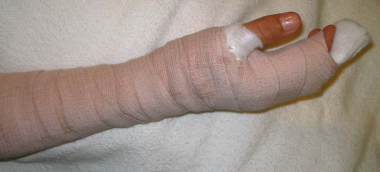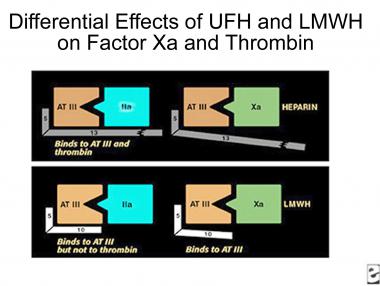

In general, splints are applied to decrease movement and provide support and comfort by stabilizing an injury. Splints are primarily used to secure nonemergency injuries to the bones and soft tissues of an extremity until they can be evaluated by a consultant such as an orthopedic surgeon. Splints can also be used to assist in primary healing or to achieve temporary immobilization of an extremity before surgery (eg, in a patient with an open fracture).[1]
Unlike casts, splints are noncircumferential and often preferred in the emergency department setting, in that injuries are often acute and continued swelling can occur. All patients with injuries that are splinted should be referred for evaluation by a consultant in a timely fashion (usually within 2-7 days, depending on the reason for splinting).[2] (See the image below.)
 Radial gutter splint. Image courtesy of Kenneth R Chuang, MD.
Radial gutter splint. Image courtesy of Kenneth R Chuang, MD.
For information on surgical treatment of such injuries, see Carpal Fractures; Metacarpal Fractures; Radius, Distal Fractures; Hand, Metacarpal Fractures and Dislocations; and Hand, Phalangeal Fractures and Dislocations.
NextA radial gutter splint can be used for various injuries, including the following:
There are no absolute contraindications for radial gutter splinting. The following injuries require immediate evaluation or intervention by a consultant (eg, orthopedic surgeon, hand surgeon, or plastic surgeon) and should not be treated with splinting alone:
The hand contains five metacarpal bones. Each metacarpal has a base, a shaft, a neck, and a head. The first metacarpal bone (thumb) is the shortest and most mobile. It articulates proximally with the trapezium. The other four metacarpals articulate with the trapezoid, capitate, and hamate at the base. Each metacarpal head articulates distally with the proximal phalanges of each digit. The hand also contains 14 phalanges. Each digit contains three phalanges (proximal, middle, and distal), except for the thumb, which has only two phalanges.
Note that some orthopedic surgeons recommend a volar splint instead of a radial gutter splint for angulated neck fractures of the second and third metacarpals. Check with the orthopedist who performs follow-up care to find out which type of splint he or she recommends.
A radial gutter splint is often applied for uncomplicated metacarpal fractures. When a metacarpal fracture is present, a clinical examination for malrotation should also be performed. With the second through fifth fingers slightly flexed, the nail beds of adjacent fingers should lie in the same plane. With 90° flexion of the metacarpophalangeal (MCP) and proximal interphalangeal (PIP) joints and with distal interphalangeal (DIP) joint extension, the second through fifth fingers should point toward the scaphoid. It may be useful to compare with the unaffected hand.
In the second and third metacarpals, 10° of angulation is acceptable; in the fourth metacarpal, 20° of angulation is acceptable; and in the fifth metacarpal, 30° of angulation is acceptable. Higher degrees of angulation often require surgery.
Periprocedural Care Deep Venous Thrombosis Prophylaxis in Orthopedic Surgery: Overview, Mechanical Methods, Pharmacologic Methods
Deep Venous Thrombosis Prophylaxis in Orthopedic Surgery: Overview, Mechanical Methods, Pharmacologic Methods
Copyright © www.orthopaedics.win Bone Health All Rights Reserved